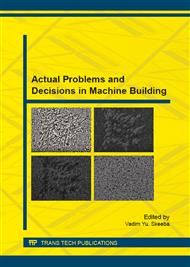p.35
p.41
p.46
p.52
p.58
p.63
p.69
p.75
p.82
Laser-Plasma Treatment of Structural Steel
Abstract:
To conduct high production hardening modification of iron-carbon and titanium alloy surface layers a laser-plasma method (LPM) is developed. The method is based on the use of optical pulse discharge plasma. A discharge is ignited with laser pulses repeated with a high frequency by a CO2-laser oscillator - amplifier system. A laser pulse is focused on the treated surface. To form plasma in alignment with the beam in the laser head, a high velocity gas flow (air, nitrogen, argon, and carbon dioxide) is created. The pressure of the plasma-forming gas can reach 0.5 MPa, and the output speed of the laser head can be 300 m/s.The results of the experiment on the impact of laser-plasma action on the structure and microhardness of the structural steel surface are presented. Laser-plasma treatment leads to the formation of a layer with the martensitic structure on the surface of structural low-alloyed steel 40Kh. This layer is formed due to quenching in a liquid state (QLS) and quenching in a solid state (QSS). The microhardness of the martensitic layer is 11-13 GPa, the hardened zone depth reaches 0.3 mm. It is proposed to use laser-plasma treatment of structural steel as a method for the local surface hardening of machine parts and tools.
Info:
Periodical:
Pages:
58-62
Citation:
Online since:
August 2015
Keywords:
Price:
Сopyright:
© 2015 Trans Tech Publications Ltd. All Rights Reserved
Share:
Citation:


